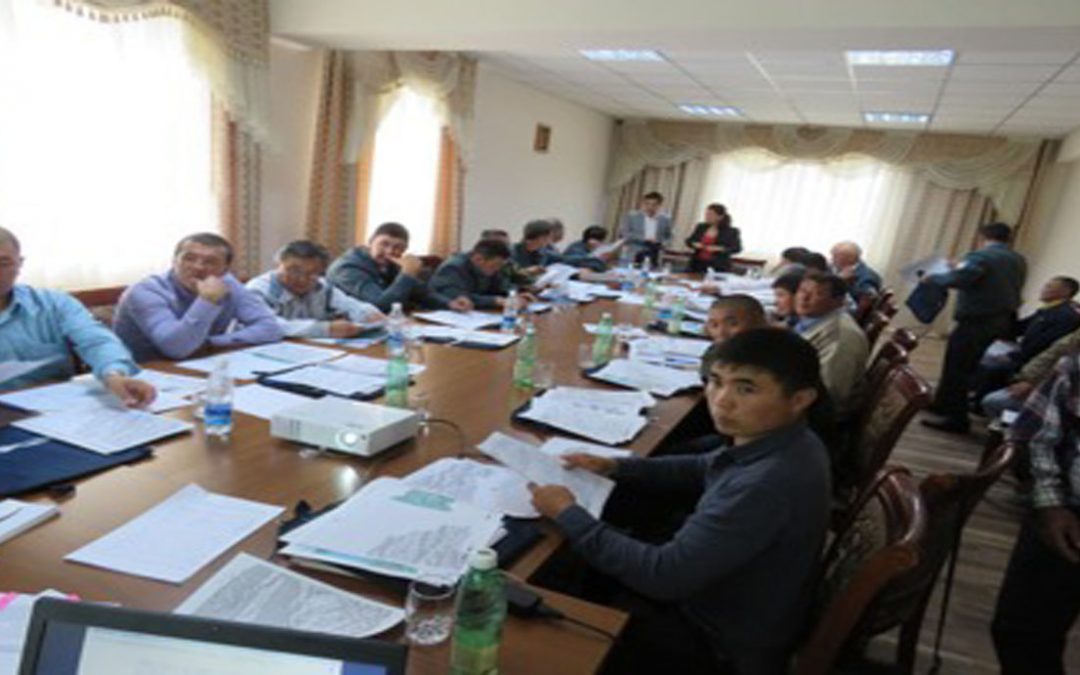17 июня 2016 года в г.Каракол прошел стартовый семинар по сбору и анализу информации для подготовки Плана управления для территории Центрального Тань-Шаня. Данный семинар проходил в рамках достижения общей цели Глобальной программы по сохранению снежного барса и его экосистем GSLEP «Обезопасить 20 ландшафтов обитания снежного к 2020 году».
Семинар был организован Секретариатом глобальной программы GSLEP при поддержке Государственного агентства охраны окружающей среды и лесного хозяйства при Правительстве Кыргызской Республики и ПМГ ГЭФ в Кыргызской Республике. Секретариат Глобальной программы GSLEP всем участникам встречи представил общую информацию, а также определил основные задачи и цели семинара, наряду с этим были обсуждены последующие шаги для разработки самого Плана управления.

Chyngyz Kochorov of the GSLEP secretariat.
Также всем участникам была доведена информация о механизмах сбора необходимой информации, а также процедурах и предварительного анализа собранной информации (Обработка и сбор данных с использованием GPS оборудования, анкетирование) для разработки ландшафтного Плана управления для пилотной территории Центрального Тянь Шаня. Участники предложили расширить работу по ландшафту и выразили готовность обеспечить сбор необходимой информации для разработки данного плана управления. Всем участникам были разданы рабочие материалы, анкеты, карты, необходимые для выездов на территорию и проведения полевых работ. Полевые работы в рамках данной инициативы запланированны на июль 2016 года. Справочно: На текущем этапе Госагентство образовало рабочую по подготовке Плана управления, куда входят представители департаментов развития лесных экосистем и ООПТ, рационального использования, а также лесоохотустройства. Помимо этого, в группу вошли представители международного сектора как: Сноу леопард траст SLT, Сноу леопард фаундэйшн SLF, Всемирный фонд дикой природы WWF и другие партнеры. Указанная группа уже начала работу и вести соответствующие консультации с заинтересованными сторонами в рамках разработки Плана управления.
ion planning at the landscape level to protect the iconic snow leopard.
May 1st, 2016 Nine snow leopard range countries convened in Kathmandu last week for a workshop on climate- smart landscape management planning and mapping in order to conserve the snow leopard and its habitat. The workshop started on Wednesday, April 20, and the first half focused on building capacity for landscape level planning for snow leopard conservation among participant countries. Over 40 practitioners from nine countries attended the workshop organized by the Global Snow Leopard Ecosystem Protection Program (GSLEP) Secretariat and the Government of Nepal. The workshop was held with support from the Snow Leopard Trust and the WWF Conservation and Adaptation in Asia’s High Mountains Project which is funded by USAID. Participants included representatives of snow leopard range nation governments, NGOs, and researchers . The snow leopard’s habitat is spread out across Asia’s vast high mountain landscapes.. To protect this iconic species, the twelve snow leopard range countries identified the need to go beyond isolated protected areas and conduct conservation efforts at a larger landscape level. In October 2013, all 12 range countries came together and unanimously adopted the Bishkek Declaration on Snow Leopard Conservation and the GSLEP Program, under which these nations committed to securing 20 snow leopard landscapes by 2020. “This workshop is part of the process to secure 20 snow leopard landscapes by 2020,” said Koustubh Sharma, the GSLEP program’s international coordinator. “A lot of the work has already been completed, and we hope our work here will result in landscape management plans which will be blueprints for securing the snow leopard landscapes.” The first four days of the workshop focused on providing tools to practitioners so they can be champions for climate-smart landscape-level planning and management for snow leopard conservation. Working in groups, participants hammered out preliminary risk analyses that will serve as the basis for developing comprehensive landscape management plans addressing key issues and threats, including climate change. “Climate change is happening more rapidly, and having more visible effects in the high mountains of Asia than many other regions of the world,” said Ryan Bartlett, Senior Program Officer for Climate Change Adaptation at WWF. “it is thus critical to address climate change in our conservation programs; otherwise we risk losing any progress in conserving the snow leopard and the ecosystems and habitat it represents that provide critical services for millions of people downstream.” Climate change and conservation planning experts from WWF and Columbia University’s Center for Climate Systems Research guided participants through the process of incorporating climate change impacts into their landscape conservation models. Climate change was included as a driver that had direct impacts on the snow leopard, but also exacerbated existing threats like over-grazing, poaching and retaliatory killing. The teams then prioritized these threats, and their mitigation strategies using criteria such as cost, feasibility, and whether the strategy would be effective in all of the climate scenarios. “While each country ultimately formulates its own plans, there was a certain amount of standardization in the country plans for the Global Tiger Initiative. That was important because we were then able to go to global funders like the international finance institutions,” said Keshav Varma, Head of the Global Tiger Initiative Council, addressing the country representatives at the closing of the landscape planning workshop. Mr. Varma also encouraged countries to tap international expertise and resources for their snow leopard conservation work. “If you think there are resources out there that we can bring to help you as you formulate your plans, we would be more than willing to help,” he added. The second half of the workshop focused on mapping work in support of landscape management plan development and implementation. Topics addressed not only included snow leopard and habitat distribution, particularly under a changing climate, but also mapping of development activities, natural resources, and the connections between snow leopard habitat and important areas for water supply. Participants will meet again at the “Landscape Management Planning Stocktaking Dialogue,” to be held at the Wildlife Institute of India in Dehradun in four months.



